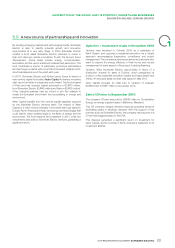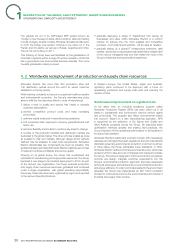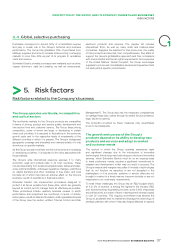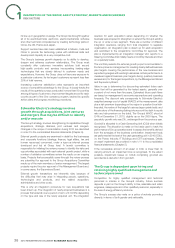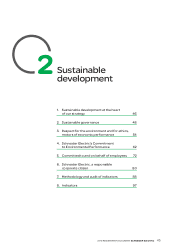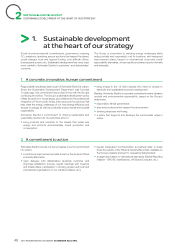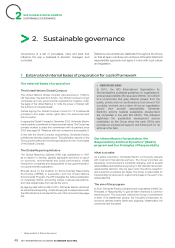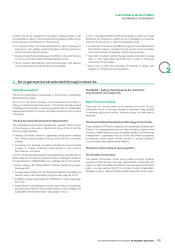APC 2010 Annual Report Download - page 43
Download and view the complete annual report
Please find page 43 of the 2010 APC annual report below. You can navigate through the pages in the report by either clicking on the pages listed below, or by using the keyword search tool below to find specific information within the annual report.
DESCRIPTION OFTHEGROUP, ANDITSSTRATEGY, MARKETS ANDBUSINESSES
1
RISK FACTORS
on our increased costs to customers, this could have an adverse
impact on its fi nancial results.
The Group has, however, implemented certain procedures to
limit its exposure to rising non-ferrous and precious raw material
prices. The purchasing departments of the operating units report
their purchasing forecasts to the Corporate Finance and Treasury
Department. Purchase commitments are hedged using forward
contracts, swaps and, to a lesser extent, options.
The fi nancial instruments used to hedge the exposure of the Group
to fl uctuations in raw material prices are described in note26 to the
consolidated fi nancial statements for the year ended December31,
2010.
In 2010, purchases of raw materials totaled around EUR1,320million,
including around EUR680 million for non-ferrous and precious
metals, of which roughly 55% was for copper. The Group enters
into swap and options agreements in order to hedge all or part of
its non-ferrous and precious metals purchases. Decisions to hedge
such purchases depend on Group forecasts of changes in market
prices. At December31, 2010, the Group had hedged positions
with a nominal value of EUR51million on these transactions.
Counterparty risk
Financial transactions are entered into with carefully selected
counterparties. Banking counterparties are chosen according
to the customary criteria, including the credit rating issued by an
independent rating agency.
Group policy consists of diversifying counterparty risks and periodic
controls are performed to check compliance with the related rules.
In addition, the Group takes out substantial credit insurance and
uses other types of guarantees to limit the risk of losses on trade
accounts receivable.
Liquidity risk
Liquidity is provided by the Group’s cash and cash equivalents
and commercial paper programs. These programs are backed
by undrawn confi rmed lines of credit. At December31, 2010, the
Group had access to cash and cash equivalents and commercial
paper programs totaling EUR3.4billion. As of December31, 2010,
the Group had EUR2.7billion in undrawn confi rmed lines of credit,
of which EUR2.6billion matures in June2012 or later.
The Group’s credit rating enables it to raise signifi cant long-term
fi nancing and attract a diverse investor base. The Group currently
has an A- credit rating from Standard & Poor’s and an A3 credit
rating from Moody’s. The Group’s liabilities and their terms and
conditions are described in note24 of Chapter 5.
In line with the Group’s overall policy of conservatively managing
liquidity risk and protecting its fi nancial position, when negotiating
new liquidity facilities the Group resists the inclusion of clauses that
would have the effect of restricting the availability of credit lines,
such as covenants requiring compliance with certain fi nancial ratios
and material adverse change clauses. As of December31, 2010,
no fi nancing or confi rmed lines of credit were subject to covenants
requiring compliance with fi nancial ratios.
The loan agreements or lines of credit for some of the Group’s
liquidity facilities include cross default clauses. If the Group were to
default on any of its liquidity facilities, it could be required to repay
the sums due on some of these facilities.
Moreover, anticipated reimbursement provisions exist for certain
fi nancing and lines of credit in case of change of control. Under
these provisions, the debt holders may demand repayment if a
shareholder or shareholders acting together hold more than 50% of
the Company’s shares, for the majority of contracts, and this event
triggers a downgrading of the Company’s rating. At December31,
2010, the amount of fi nancing and lines of credit with these types of
provisions came to EUR4.2billion.
Legal risks
The Group’s products are subject to varying
national and international standards and
regulations
The Group’s products, which are sold in national markets
worldwide, are subject to regulations in each of those markets,
as well as to various supranational regulations. Those regulations
include trade restrictions, tariffs, tax regimes and product safety
standards. Changes to any of these regulations or standards or
their applicability to the Group’s business could lead to lower sales
or increased operating costs, which would result in lower profi tability
and earnings.
The Group’s products are also subject to multiple quality and safety
controls and regulations, and are governed by both national and
supranational standards, though the majority of the line up complies
with world-recognised International Electrotechnical Commission
(IEC) standards. Costs of compliance with new or more stringent
standards and regulations could affect its business if the Group is
required to make capital expenditures or implement other measures.
The development and success of the Group’s
products depends on its ability to protect its
intellectual property against competitors
The Group’s future success depends to a signifi cant extent on the
development and maintenance of its intellectual property rights.
Third parties may infringe the Group’s intellectual property rights,
and the Group may expend signifi cant resources monitoring,
protecting and enforcing its rights. If the Group fails to protect or
enforce its intellectual property rights, its competitive position could
suffer, which could have an adverse effect on its business.
To mitigate this risk, the patents developed or purchased by the
Group are tracked by the Industrial Property team within the
Finance & Control – Legal Affairs Department. All industrial property
information for the main Group subsidiaries is transmitted to this
team, which is responsible for managing and protecting these
intangible assets throughout the world. The same procedure is
followed for trademarks.
2010 REGISTRATION DOCUMENT SCHNEIDER ELECTRIC 41




